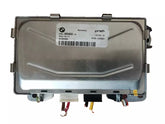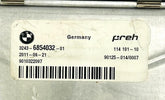مقدمة
عندما يبدأ مكيف هواء سيارتك بنفخ هواء دافئ، فإن أحد الأسباب الأكثر شيوعًا هو تسرب غاز التبريد، والذي غالبًا ما يكون ناتجًا عن ضاغط مكيف الهواء. يلعب ضاغط مكيف الهواء دورًا أساسيًا في الحفاظ على برودة سيارتك من خلال توزيع غاز التبريد في جميع أنحاء النظام. مع مرور الوقت، قد تتطور التسريبات بسبب تآكل الأختام، أو التلف المادي، أو التآكل.
الكشف المبكر عن تسرب غاز مكيف الهواء يوفر عليك تكاليف الإصلاحات ويحافظ على كفاءة نظامك. في هذه المدونة، ترشدك أوتومان سبير بارتس خطوة بخطوة حول كيفية التحقق من تسرب الغاز في ضاغط مكيف السيارة باستخدام طرق متنوعة، بدءًا من الفحص البصري البسيط ووصولًا إلى الأدوات المتطورة.
لماذا يحدث تسرب غاز التكييف؟
قبل الخوض في عملية الكشف، من المفيد أن نفهم ما قد يسبب التسرب في المقام الأول.
-
أختام أو حشوات الشيخوخة
-
الشقوق أو التآكل في غلاف الضاغط
-
وصلات الخرطوم الفضفاضة أو التالفة
-
اهتزاز أو حرارة زائدة
حتى التسرب الصغير يمكن أن يؤدي إلى فقدان نظام تكييف الهواء الخاص بك للكفاءة، مما يؤدي إلى ضعف التبريد وزيادة التآكل على الضاغط.
كيفية اكتشاف تسرب الغاز في ضاغط مكيف الهواء الخاص بك
هناك عدة طرق للكشف عن تسرب غاز التبريد، وذلك حسب الأدوات المتاحة ودرجة خطورة المشكلة. فيما يلي أكثر الطرق فعالية:
1. الفحص البصري
ابدأ بفحص بصري أساسي أسفل الغطاء:
-
قم بإلقاء نظرة على غلاف ضاغط التيار المتردد ، وخاصة حول الوصلات ووصلات الخرطوم.
-
افحص بحثًا عن بقع الزيت أو البقع الرطبة أو البقايا - غالبًا ما يتسرب سائل التبريد مع كمية صغيرة من زيت الضاغط.
-
افحص الحلقات الدائرية والأختام بحثًا عن علامات الشيخوخة أو الشقوق.
تعتبر هذه الطريقة بسيطة ولكنها قد لا تكون كافية للكشف عن التسريبات الصغيرة أو البطيئة.
2. استمع إلى صوت الهسهسة
قم بإيقاف تشغيل المحرك واستمع بعناية بالقرب من منطقة الضاغط.
قد يشير صوت هسهسة أو فقاعات خافتة إلى تسرب مادة التبريد. يحدث هذا عادةً فقط أثناء وجود تسرب نشط، وهو نادر إلا إذا كان الثقب كبيرًا.
3. اختبار رش الصابون والماء
يمكن أن تساعد هذه الطريقة الكلاسيكية في اكتشاف التسريبات المرئية:
-
قم بخلط صابون الأطباق مع الماء في زجاجة رذاذ.
-
رش بسخاء على وصلات الضاغط وصمامات الضغط ووصلات الخرطوم .
-
انتبه إلى تشكل الفقاعات - فهذه علامة واضحة على وجود تسرب.
يعد هذا الاختبار آمنًا وغير مكلف، لكنه قد لا يتمكن من اكتشاف التسريبات الأصغر حجمًا.
4. اختبار الصبغة فوق البنفسجية
تعتبر طريقة الصبغة فوق البنفسجية طريقة احترافية ودقيقة للغاية للكشف عن تسربات التيار المتردد.
خطوات:
-
أضف الصبغة الفلورية إلى نظام التيار المتردد باستخدام محقن الصبغة فوق البنفسجية.
-
قم بتشغيل مكيف الهواء لمدة 10 إلى 15 دقيقة لتوزيع الصبغة في جميع أنحاء النظام.
-
استخدم مصباح الأشعة فوق البنفسجية لمسح المنطقة المحيطة بالضاغط والخراطيم والتجهيزات.
-
ابحث عن صبغة خضراء أو صفراء زاهية عند نقطة التسرب.
ارتدِ دائمًا نظارات واقية وقفازات عند التعامل مع صبغة الأشعة فوق البنفسجية.
5. كاشف التسرب الإلكتروني
تُستخدم هذه الأداة عادةً بواسطة الميكانيكيين وتكتشف غازات التبريد بسرعة.
-
قم بتحريك المستشعر حول مفاصل الضاغط والخراطيم وصمامات الخدمة .
-
إذا تم الكشف عن وجود مادة مبردة، ستصدر الأداة صوت تنبيه أو إشارة ضوئية .
-
مثالي للعثور على التسريبات الصغيرة التي لا يمكن رؤيتها بالعين.
تعتبر أجهزة الكشف الإلكترونية أكثر حساسية وموثوقية من الطرق الأساسية.
6. اختبار ضغط النيتروجين (متقدم)
إذا كان النظام فارغًا أو تم إخلاؤه، فيمكن للميكانيكيين استخدام هذه الطريقة:
-
قم بملء نظام التيار المتردد بالنيتروجين الجاف باستخدام مقياس متعدد.
-
راقب انخفاض الضغط بمرور الوقت.
-
استخدم محلول الصابون على المفاصل للعثور على مكان تسرب الغاز.
يتم إجراء هذا الاختبار عادة في ورشة عمل بسبب المعدات المتخصصة المطلوبة.
هل تسرب المبرد له رائحة؟
أحد الأسئلة الأكثر شيوعًا التي يطرحها أصحاب السيارات هو ما إذا كان بإمكانك شم رائحة تسرب غاز التبريد من نظام تكييف الهواء في سيارتك.
في معظم الحالات، الجواب هو لا.
المبردات مثل R134a و R1234yf ، والتي تستخدم عادة في المركبات الحديثة، هي:
-
عديم الرائحة أو ذو رائحة حلوة خفيفة
-
عديم اللون وغير قابل للاشتعال (في الظروف العادية)
-
من الصعب اكتشافه عن طريق الرائحة وحدها
مع ذلك، في حالات نادرة، قد تُلاحظ رائحة حلوة أو كيميائية أو شبيهة بالكلوروفورم إذا كان التسرب كبيرًا. إذا شممت رائحة غير عادية، فمن الأفضل فحص النظام فورًا، لأن استنشاق غاز التبريد في الأماكن المغلقة قد يكون ضارًا.
روائح مكيف الهواء غير العادية الأخرى ومعناها
أحيانًا، ما تشمّه ليس مُبرّدًا على الإطلاق. إليك بعض الاحتمالات:
| يشم | السبب المحتمل | هل يتعلق الأمر بالتسرب؟ |
|---|---|---|
| متعفن أو متعفن | العفن في المبخر أو القنوات | لا |
| خل أو حامض | نمو البكتيريا في الفتحات | لا |
| حرق أو كيميائي | مشكلة كهربائية أو ارتفاع درجة حرارة الضاغط | ربما |
| حلو أو يشبه الكلوروفورم | تسرب كبير للمبرد | نعم |
إذا لاحظت أيًا من هذه الروائح، فاطلب من ميكانيكي محترف تشخيص نظام تكييف الهواء.
الأفكار النهائية
يُعد فحص تسرب الغاز في ضاغط مكيف السيارة صيانةً أساسيةً للحفاظ على برودة سيارتك وكفاءة نظام تكييف الهواء. في حين أن بعض التسريبات يسهل اكتشافها، إلا أن بعضها الآخر يتطلب أدواتٍ أكثر تطورًا مثل صبغات الأشعة فوق البنفسجية أو أجهزة الكشف الإلكترونية.
إذا كنت تشك في وجود تسرب، فمن الأفضل التصرف بسرعة قبل تفاقم المشكلة . تجاهل تسربات غاز التبريد قد يؤدي إلى تلف الضاغط، وانخفاض كفاءة استهلاك الوقود، ويؤدي إلى إصلاحات مكلفة.
في أوتومان لقطع الغيار ، نقدم ضواغط وأجزاء تكييف أصلية لمجموعة واسعة من المركبات. إذا كنت ترغب في استبدال ضاغطك أو مكوناته، فتأكد من تصفح كتالوجنا للحصول على أسعار تنافسية وشحن سريع.







